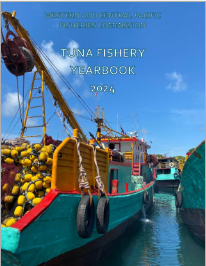WCPFC Tuna Fishery Yearbook - Annual Catch Estimates
 The Western and Central Pacific Fisheries Commission (WCPFC) Tuna Fishery Yearbook presents annual catch estimates in the WCPFC Statistical Area from 1970 to 2023 (#1)
The Western and Central Pacific Fisheries Commission (WCPFC) Tuna Fishery Yearbook presents annual catch estimates in the WCPFC Statistical Area from 1970 to 2023 (#1)
The tables of catch statistics cover the WCPFC key tuna and billfish species caught in the region: albacore (Thunnus alalunga), bigeye (Thunnus obesus), skipjack (Katsuwonus pelamis), yellowfin (Thunnus albacares), black marlin (Makaira indica), blue marlin (Makaira nigricans), striped marlin (Tetrapturus audax) and swordfish (Xiphias gladius). The WCFPC, through their member countries, are now obliged to compile estimates of key shark species, some of which are now covered in the longline fleet tables: blue shark (Prionace glauca), silky shark (Carcharhinus falciformis), oceanic whitetip shark (Carcharhinus longimanus) and mako sharks (Isurus spp.).
Catches of other species are not covered explicitly and estimates of discards (weight) have only been included in total catch by species since 2017 (see SPC-OFP, 2024), noting that estimates of discards in number are not yet included. Recent studies have used observer data in order to better estimate bycatch and discards in the longline and purse seine fisheries (see Peatman et Nicol, 2023; Peatman et al. 2024).
The main industrial fishing methods employed in the WCPFC region include longline, pole-and-line, purse seine and troll. The domestic fisheries of Indonesia and the Philippines employ several other methods. Driftnet fishing for albacore in the South Pacific Ocean ceased in 1991. Individual fleets presented herein cover vessels that are flagged to that nation and those vessels considered to be ‘chartered’ according to the WCPFC Conservation and Management Measure (CMM-2021-04) on Charter Notification.
Statistical tables covering individual fleets are followed by tables summarising the numbers of vessels and catches by species and gear type in the WCPFC Statistical Area. Tables are presented summarising the catch by species in the Western and Central Pacific Ocean (WCPO) and the Eastern Pacific Ocean (EPO), the North and South Pacific Oceans, and the WCPFC Area north and south of the equator. Global catches by gear and species are also presented.
For the purse-seine fishery, recent studies using observer data (e.g. Lawson, 2007, Lawson, 2010, Lawson, 2012, Lawson, 2013, Lawson, 2014, Hampton and Williams, 2011, Hampton and Williams, 2017) show that the logsheet-reported catch, mainly for associated sets, should contain higher quantities of yellowfin and bigeye tuna that have been misreported as skipjack tuna. Purse-seine catch estimates that have been adjusted with species compositions determined from observer grab samples corrected for size selectivity bias (see Peatman et al., 2019 for the latest methodology) are presented herein as the best available WCFPC purse-seine catch estimates for skipjack, yellowfin and bigeye tuna. All composite tables and figures referring to purse-seine species catch are consistent with these estimates. The estimates of purse seine catch by species may differ from the original estimates provided by WCPFC member countries for their fleets, but total purse seine catch will not differ. The purse seine species catch estimates are produced from statistical models and will therefore change from year to year as more data become available. The unadjusted, logsheet-reported purse-seine species catches, as submitted by member countries to the WCPFC, are included in the purse seine fleet tables in grey, italic font.
For the longline fishery, estimates of key shark species have improved in recent years but for most fleets remain uncertain due to (i) clear under-reporting of catches, or (ii) very low coverage of observer data used to estimate these catches. The estimates of longline catches of key shark species that are considered uncertain appear in grey, italic font.
The tables of annual catch estimates for individual fleets cover those years during which the fleet is known to have fished; the lack of recent years in a table implies that the fleet has ceased fishing. The tables of annual catch statistics for individual fleets are accompanied by bar charts showing annual catches. Maps of catches taken by individual fleets have been omitted to avoid potential non-compliance with the WCPFC’s rule that public domain data cover a minimum of three vessels, but maps adhering to the WCPFC rules are available in the WCPFC ACE Tables.
The sources of the estimates are available from the SPC Oceanic Fisheries Programme.
WCPFC Tuna Fishery Yearbook 2024 (![]() 17.8 MB)
17.8 MB)
Annual Catch Estimates 2023 - data files (![]() 296.39 KB)
296.39 KB)
You can also access our online query interface after registering yourself:

